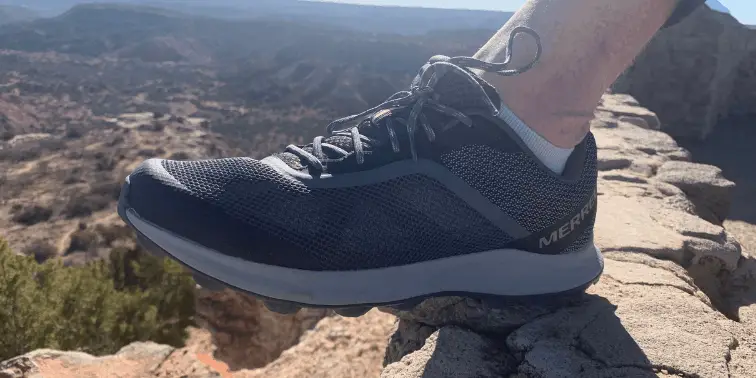While buying trail running shoes, online or offline, people usually focus on their style, price and color. If they do a little more research they may look at fit and tread. But many people will often miss one of the most important features in trail running shoes: the rock plate.
In this write-up, we are going to introduce you to this unique feature in shoes made for running on trails as well as why it’s important.
The rock plate in shoes trail running shoes is a firm piece of material made of carbon fiber or plastic to protect the feet of the runner while running on irregular shaped and sharp stones and roots. This plate is inserted in between the midsole and outsole of the shoe to provide extra protection while running on the trail.
In other words, a rock plate’s job is to protect your feet from pain and instability that can be caused by obstacles you may find along the trail. This plate will not only protect your feet on rocky trails but also allow you to increase your speed more confidently while running on trails. It also permits you to run on sharp objects without worrying about injuring your feet.
What types of shoes have a rock plate?
Though all running shoes are made to ensure the safety of the runners’ feet, trail running shoes are specially designed to protect as well as provide stability to the feet of runners.
So, while shoes designed for running on the road will not come equipped with a rock plate, some (not all) trail running shoes will have them. Rock plates can also be found in many hiking boots for the same reasons you’d find a rock plate in trail running shoes.
Rock plates can serve as a critical component in trail shoes design. Most shoes used for trail running with minimalistic design have a rock plate in between their hard outsole and soft midsole to protect your feet on rocky trails.
The main purpose of a rock plate in trail shoes is to safeguard your feet from bruises caused by sharp stones and rocks. Though shoes used for running on trails become a bit stiffer than the shoes used for running on the road, it is still beneficial to run long distances on technical trails due to the protection provided by them.
Trail Shoes are designed especially for running on uneven off-road trails with rots, mud, rocks, and other impediments found on such surfaces. Though you can find various types of trail shoes ranging from slightly cushioned shoes like flat racing shoes to bulky big shoes like hiking boots but while buying them you will have to consider a few things like:
- Distance to run
- Weather conditions
- Type of trail
But most of the trail shoes have a few things common in them like lugs and a reinforced upper.
Lugs: Lugs are the enhanced tread on the sole of trail shoes that allow you to run on slippery or loose surfaces safely by providing you solid traction. You may prefer shoes with a low lug if you are going to run on a hard dirt surface. However, for steep rocky terrain or wet, muddy conditions, larger lugs are incredibly beneficial to help you keep your grip to the trail underneath you.
Reinforced upper: The upper of trail shoes is normally made heavier and more durable so that they can withstand abuse while running on rocky and rough trails. Basically, the extra durable material holds up better against snags and pokes from thorns, sticks and rocks.
What are the pros and cons of having a rock plate?

Most of the trail shoes used for running on off-road trails are designed modestly and include rock plates in between the hard outsole and soft and cushy midsole because of various types of benefits provided by them to the runners.
Pros of a Rock Plate in Trail Shoes:
Protection: The main benefit of the rock plate in trail shoes is that it protects your feet while running on technical terrains with sharp stones and rocks. This feature makes trail shoes different from the shoes used for running on the road as it allows you to run for long distances on off-road trails.
Stability: Together with providing protection to your feet rock plates in your trail running shoes also provide you stability while running on uneven tracks. They help in avoiding awkward placement of your feet while running on sharp debris and objects.
In this way, rock plates can allow you to run on uneven trails without worrying about injuries caused by the wrong placement of your feet as well as the poking of sharp rocks and stones into your feet through their sole.
Cons of a Rock Plate in Trail Shoes:
The only real drawback of having a rock plate in a trail shoe is that it can add weight to the shoes. Adding weight to a running shoe is always something you try to avoid if possible.
Having said that, I purchased three trail running shoes recently for a comparison article I was doing. The Merrill ATL Skyfire was the only one of three I tested that had a rock plate. It was also the lightest shoe of the bunch. So, don’t assume that just because a shoe has a rock plate that it is going to be heavier.
Final Thoughts
The main purpose of using a rock plate in trail running shoes is to protect the feet of the runner from the injuries caused by the sharp and uneven rocks and stones while running on off-road trails. To increase protection under your feet from the sharp debris and objects a rock plate made from carbon fiber or firm plastic is implanted in between the outsole and midsole of the shoes used for trail running.
In this way, the rock plate in the sole of trail shoes will protect your feet from the harm caused by rocks and stones on rugged trails while running on them. Along with protecting your feet from sharp stones, rocks and other objects this rock plate can also increase your confidence to increase your speed while running on uneven trails without worrying about the injuries your feet can experience on rocky trails.
